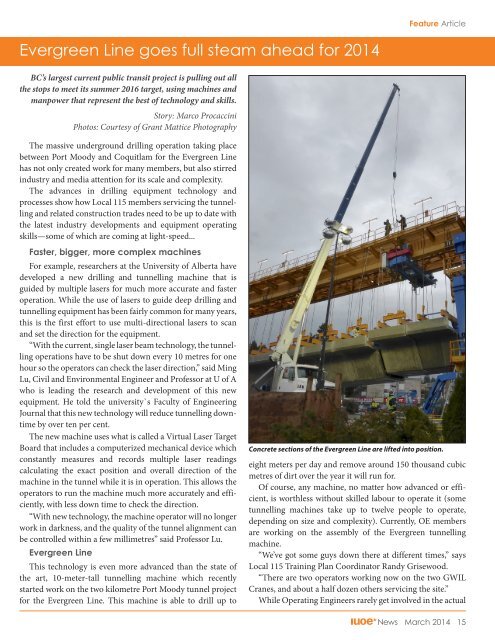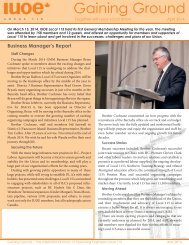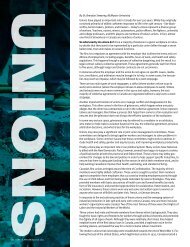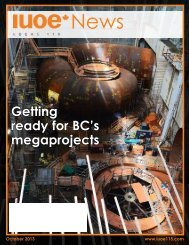IUOE News Spring 2014
The March 2014 edition of the OE News, the official quarterly publication of the International Union of Operating Engineers Local 115
The March 2014 edition of the OE News, the official quarterly publication of the International Union of Operating Engineers Local 115
Create successful ePaper yourself
Turn your PDF publications into a flip-book with our unique Google optimized e-Paper software.
Feature Article<br />
Evergreen Line goes full steam ahead for <strong>2014</strong><br />
BC’s largest current public transit project is pulling out all<br />
the stops to meet its summer 2016 target, using machines and<br />
manpower that represent the best of technology and skills.<br />
Story: Marco Procaccini<br />
Photos: Courtesy of Grant Mattice Photography<br />
The massive underground drilling operation taking place<br />
between Port Moody and Coquitlam for the Evergreen Line<br />
has not only created work for many members, but also stirred<br />
industry and media attention for its scale and complexity.<br />
The advances in drilling equipment technology and<br />
processes show how Local 115 members servicing the tunnelling<br />
and related construction trades need to be up to date with<br />
the latest industry developments and equipment operating<br />
skills—some of which are coming at light-speed...<br />
Faster, bigger, more complex machines<br />
For example, researchers at the University of Alberta have<br />
developed a new drilling and tunnelling machine that is<br />
guided by multiple lasers for much more accurate and faster<br />
operation. While the use of lasers to guide deep drilling and<br />
tunnelling equipment has been fairly common for many years,<br />
this is the first effort to use multi-directional lasers to scan<br />
and set the direction for the equipment.<br />
“With the current, single laser beam technology, the tunnelling<br />
operations have to be shut down every 10 metres for one<br />
hour so the operators can check the laser direction,” said Ming<br />
Lu, Civil and Environmental Engineer and Professor at U of A<br />
who is leading the research and development of this new<br />
equipment. He told the university`s Faculty of Engineering<br />
Journal that this new technology will reduce tunnelling downtime<br />
by over ten per cent.<br />
The new machine uses what is called a Virtual Laser Target<br />
Board that includes a computerized mechanical device which<br />
constantly measures and records multiple laser readings<br />
calculating the exact position and overall direction of the<br />
machine in the tunnel while it is in operation. This allows the<br />
operators to run the machine much more accurately and efficiently,<br />
with less down time to check the direction.<br />
“With new technology, the machine operator will no longer<br />
work in darkness, and the quality of the tunnel alignment can<br />
be controlled within a few millimetres” said Professor Lu.<br />
Evergreen Line<br />
This technology is even more advanced than the state of<br />
the art, 10-meter-tall tunnelling machine which recently<br />
started work on the two kilometre Port Moody tunnel project<br />
for the Evergreen Line. This machine is able to drill up to<br />
Concrete sections of the Evergreen Line are lifted into position.<br />
eight meters per day and remove around 150 thousand cubic<br />
metres of dirt over the year it will run for.<br />
Of course, any machine, no matter how advanced or efficient,<br />
is worthless without skilled labour to operate it (some<br />
tunnelling machines take up to twelve people to operate,<br />
depending on size and complexity). Currently, OE members<br />
are working on the assembly of the Evergreen tunnelling<br />
machine.<br />
“We’ve got some guys down there at different times,” says<br />
Local 115 Training Plan Coordinator Randy Grisewood.<br />
“There are two operators working now on the two GWIL<br />
Cranes, and about a half dozen others servicing the site.”<br />
While Operating Engineers rarely get involved in the actual<br />
<strong>News</strong> March <strong>2014</strong> 15

















